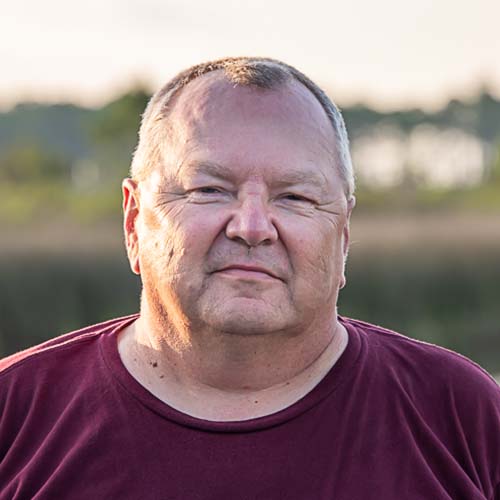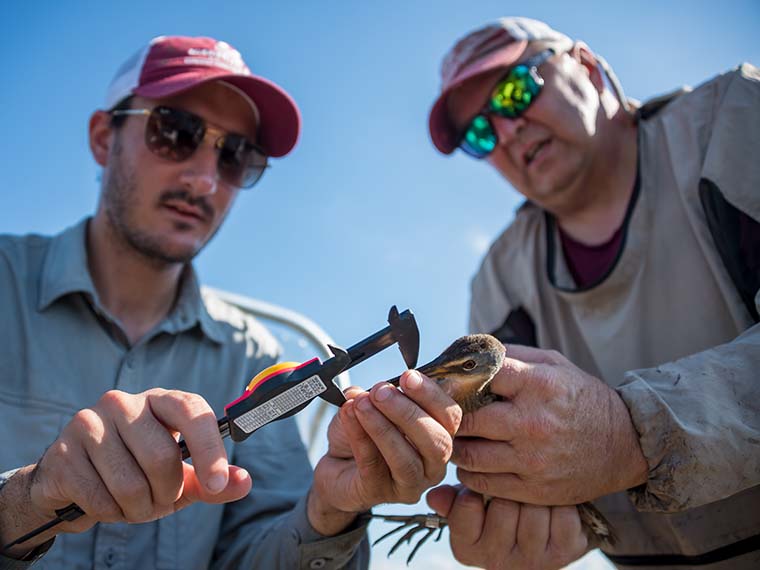The information presented on this page may be dated. It may refer to situations which have changed or people who are no longer affiliated with the university. It is archived as part of Mississippi State University's history.
Dr. Mark Woodrey-who grew up in Ohio-had an early love of birds that eventually led him to the Mississippi Gulf Coast to study coastal ecosystems, especially tidal marshes and wetland birds.
"When I was 12 years old, I met a naturalist who taught me how to band birds. The first bird I held was a Swainson's Thrush, which I learned migrates from the boreal regions of Canada south in the fall to winter in Central and South America. I clearly remember looking into the bird's eye and wondering how it made this journey and what things it saw along the way. From that day forward, I was hooked on birds," he remembered.
The MAFES scientist and assistant research professor at the Coastal Research and Extension Center recently helped spearhead a massive four-year initiative to create the Gulf of Mexico Avian Monitoring Network, or GoMAMN, to better understand the more than 500 bird species that frequent the Gulf Coast. These birds serve as an indicator of ecosystem health.
"GoMAMN was born out of the need of increased coordination and collaboration across a multitude of stakeholders and partners," Woodrey explained. "We needed to embrace a more formalized means of coordinating and integrating avian monitoring activities."
Woodrey said that while plenty of government and nongovernmental agencies are tasked with helping avian wildlife after a major natural or man-made disaster, there was no comprehensive standardized monitoring framework to truly evaluate restoration efforts across the region.
"Collectively, state and federal agencies, along with conservation organizations and citizen groups make tremendous efforts in restoration projects geared at helping birds and their habitats along the Gulf Coast," Woodrey said. "What they all need is access to streamlined avian ecology data and strategies to evaluate those restoration efforts."
Woodrey said the catalyst for creating the network was the 2010 Deepwater Horizon Oil Spill with the work funded by the RESTORE Act of 2012, Natural Resource Damage Assessment Trustee Council, and the National Fish and Wildlife Foundation.
"After the oil spill, since there wasn't a formal framework in place to measure natural resources including avian data on a comprehensive scale, the data we had on birds in the area was limited, so we weren't able to accurately determine how many birds were lost in that event."
Woodrey explained that more than 500 species of birds frequent the Gulf Coast.
"They either live here year-round, breed here, or migrate here during the winter months. That's a lot of species to monitor across several different habitats so we brought experts from around the Gulf together to come up with a plan on how we can count and monitor these birds so that the next time there is a significant event, we have the baseline data to determine impact."
Woodrey said the team that created GoMAMN included more than 100 individuals representing more than 30 agencies and organizations who participated in meetings, workshops, conference calls, and webinars to provide input and expertise.
"We used what's called decision science-a particular process called structured decision making that takes a complex problem and breaks it down into smaller components step by step," Woodrey said. "All of these different stakeholders have been able to form a network and a strategic plan that helps us communicate at the landscape level using the same language, so to speak."
Woodrey said the Strategic Avian Monitoring Plan-the newly formed team's first major order of business-will be a living document updated every five years that will identify needs and provide monitoring recommendations to advance collaborative and integrated bird monitoring efforts along the northern Gulf of Mexico.
"We sought to create a cost-effective monitoring strategy that can evaluate ongoing conservation activities as well as emerging ones. We want to identify existing threats-both chronic and acute-as well as new threats on the horizon. We also need to ensure existing management practices are not only effective but are also not triggering new threats," Woodrey said.
Woodrey said the work will help researchers, land managers, and funding agencies prioritize steps to take in protecting the region's birds.
"This system helps us understand how, when, and where to monitor for different species and which of those species are the highest priority," Woodrey said.
One such pressing priority identified as a result of that plan has been marsh birds in Mississippi.
In addition to his roles with MAFES and the Coastal Research and Extension Center, Woodrey is part of the Mississippi Department of Marine Resources, serving as research coordinator for the Grand Bay National Estuarine Research Reserve. Woodrey said the reserve and staff have been supportive of GoMAMN activities as a critical part of its marsh bird research and conservation program. Woodrey has partnered with Dr. Ray Iglay, assistant research professor; Dr. Kristine Evans, assistant professor; and Dr. Scott Rush, associate professor; all in the Department of Wildlife, Fisheries and Aquaculture in the College of Forest Resources and the Forest and Wildlife Research Center, on the project.
The team is addressing the monitoring and stewardship of priority marsh bird species across tidal marsh habitat along the Mississippi coast. Their goal is to gauge the biological response of different species to ongoing restoration and management actions funded by the National Fish and Wildlife's Gulf Environmental Benefit Fund.
"We also received a grant from the Mississippi Department of Environmental Quality to develop a program to monitor marsh birds in coastal Mississippi. The state is doing a lot of work on restoring coastal marshes, so we are capturing baseline data, in order to determine the number of marsh birds in coastal Mississippi. We're also going to assess how effective the marsh restoration projects are in restoring marsh bird populations," Woodrey said.
The project is a first step in implementing the GoMAMN's strategic plan across the Gulf states.
"Restoration on the Gulf-after the oil spill-was all about making the area whole again-from the region's ecology to its economic viability. It's about helping these coastal communities and habitats rebuild and be made whole again. We hope to develop a framework to collect avian data, so we know we've done what we need to do in terms of restoring these natural resources now and in the future," Woodrey said.
While Americans have a love of the coast, MAFES researchers are taking steps to make sure these dynamic living systems are protected. Whether it's ensuring coastal restoration projects make economic sense, creating a multi-state network to quantify and protect the region's birds, or better understand waves in order to help prevent coastal erosion, MAFES researchers hope to contribute to the sustainability and resilience of the region for years to come.
The research featured in this article was funded by the following entities: The Bureau of Ocean Energy Management, MAFES Special Research Initiative, RESTORE Act of 2012, Natural Resource Damage Assessment Trustee Council, the National Fish and Wildlife Foundation, and the Mississippi Department of Environmental Quality.
Restoration on the Gulf-after the oil spill-was all about making the area whole again-from the region's ecology to its economic viability. It's about helping these coastal communities and habitats rebuild...
Dr. Mark woodrey
Behind the Science

Mark Woodrey
Assistant Research Professor
Education: B.S., M.S., Zoology, The Ohio State University; Ph.D., Biological Sciences, University of Southern Mississippi
Years At MSU: 17
Focus: Ecology and conservation of coastal birds
Passion At Work: I strive to understand and conserve coastal birds because most are negatively impacted by the constant stress of human impacts along the Gulf of Mexico.

